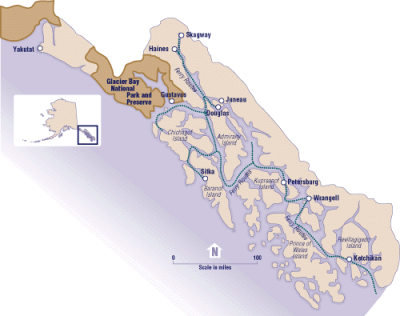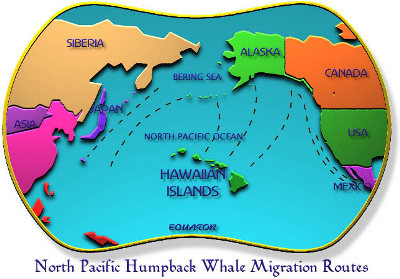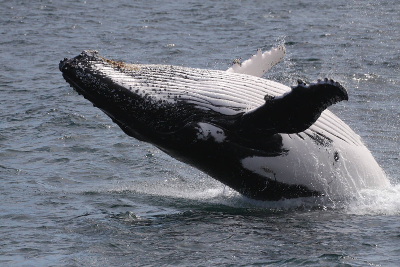
Although we were supposed to have had a rough night as we sailed out into the North Pacific we both slept like babies and this is testament to the stability of modern cruise liners. Our 7 day cruise was to take us to the sea between the coast and the numerous islands off the coast of Alaska, known as the Inside Passage. Our first port of call would be Sitka, followed by Juneau, the highlight of the cruise Glacier Bay and finally Ketchikan before making out way back via Victoria to San Francisco.
The journey to Sitka was uneventful and we just enjoyed the relaxation of the cruise ship, the varied food and the entertainment provided by the crew and guest performers. Our outside cabin with balcony was excellent and the staff couldn't do enough for you. At one mealtime Jane said she didn't want anything for desert so the waiter brought her a plate with Nothing inscribed on it in chocolate which gave us a laugh.
We disenbarked at Sitka for our first whale watching trip out into the bay where we learnt how the humpback and gray whales spend the summer months in the north pacific which is rich in the plankton and shrimplike krill that is their primary source of food; humpbacks also often eat small fish, particularly herring, which swim in large schools. They migrate at the end of November to warmer climates near Japan, Hawaii and Mexico where they breed; this is an enormous distance and can take up to two months. They stay in the warmer water without feeding until April when they return to the polar regions to feed; they will exist without food for around 4 months during which time they swim and socialise. As well as looking for whales we also saw the delightful sea otters which are very sociable and swim together in groups so they are not difficult to find, usually very close to the shore. The have a very high metabolic rate and have to feed as much as 25% of their body weight a day to keep warm and survive; consequently when you see them apparently swimming on their backs they have probably just found food and are using their free front paws to eat with. When they dive for food they will place rocks in sacs under their armpits which they use to break open shells as well as using their specially adapted teeth. Although a protected species the Alaskan indians are permitted to catch and kill so many a year for food and for their highly prized furs which are used to make coats and other clothing; this is allowed to keep their number under control.


We moved on from Sitka to Glacier Bay which is at the north end of the Inside Passage; no wonder this has been named a UNESCO World Heritage Site in 1979 and was further inscribed as a Biosphere Reserve (areas of terrestrial and coastal ecosystems) in 1986. The thing that struck me was how quiet it was as we cruised up towards the most accessible of the major glaciers (Margerie); there were no sounds other than the ship and the people on it who somehow were also silenced by the shear splendour of it. Occasionally, pieces of ice would break off the edge of the glacier (calving) which although stable in length is still moving towards the sea and you could see these small ice flows floating back down the Tarr Inlet towards Glacier Bay itself; the glacier is 21 miles long and a mile wide and is named after Emmanuel de Margerie, who visited the bay in 1913. I've attached a National Park Service fact sheet about Glacier Bay in case you are interested.
We were given a talk by Park Rangers who had come on board at Sitka about how much of the glaciers had been lost in the last few hundred years, some might say due to global warming. The Vancouver expedition (1791–95) found that Glacier Bay itself was almost entirely covered by one large tidewater glacier; in 1879 John Muir found that the ice had retreated almost all the way up the bay, a distance of around 48 miles and by 1916 the Grand Pacific Glacier was at the head of Tarr Inlet about 65 miles from Glacier Bay's mouth. Two glaciers are not in retreat however; in 2012, Johns Hopkins Glacier was found to be advancing at the rate of 3metres a day and the Margerie Glacier was stable. If you believe global warming to be a modern phenomena, then most of the loss of glaciers was in the 1800's not a period renowned for global warming and recently there has been little or no loss with some glaciers even advancing. There will always be two sides to this argument - take your pick!.

From Glacier Bay we sailed on to Juneau where we had another whale watching trip which unfortunately was less rewarding; we saw the spouts of some whales a long way off and some sea-lions close-up. Unfortunately there was one close up of a whale as it jumped out of the water but I was looking the other way and didn't see it; this iconic view of a whale leaping out of the water (shown in the internet image) is my one disappointment from the whale watching trips - just luck of the draw I guess.
Our final stop in the Inside Passage was Ketchikan which is a busy trading port but like most other Alaskan ports can only be visited by air or sea, hence almost all supplies come in by sea. In Ketchikan we went on a trip to the Saxman indian village which was recognised as a self governing body back in 1940, enshrined in federal law and they run their own affairs with an eight man tribal council. We were given a demonstration of tribal dancing and took photos of the totem poles which are carved by local indian craftsmen - worth the visit to admire how they have retained their culture whilst embracing modern life.
This was the last stop on our Alaskan cruise although we also stopped at Victoria in British Columbia, Canada. Here again we took a Red Bus tour of the city and the surrounding area before returning to ship for our final formal evening and the jouirney back to San Francisco. Our last evening on board was very enjoyable with a gala dinner and sat at our normal table with two very nice American ladies, Josefina and Doris; unfortunately after all this time I cannot remember the names of our two waiters who were great but Jane still keeps in touch with Josefina through facebook. Having been on a couple of cruises now I can definitely say that eating in a more formal way at a regular table with the same companions is preferable to eating at anytime with no-one in particular. You can get to make real contact and can actually make friends that transcend your short holiday (this has certainly been the case with our friends for life (Nick and Olwen) who we met on a Leger holiday and now go away with them every year as well as visiting each others homes. As Mohammad Ali said, "friendship is not taught in schools but if you haven't learnt the meaning of friendship you haven't learnt anything."